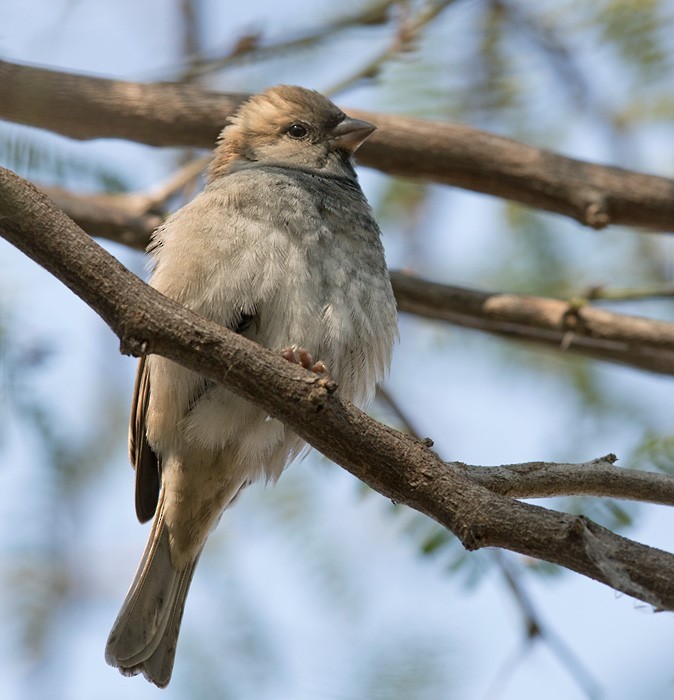Sind Sparrow
A species of Old World Sparrows Scientific name : Passer pyrrhonotus Genus : Old World Sparrows
Sind Sparrow, A species of Old World Sparrows
Botanical name: Passer pyrrhonotus
Genus: Old World Sparrows
Content
Description General Info
 Photo By Lars Petersson
Photo By Lars Petersson Description
The Sind sparrow is very similar to the house sparrow, and both sexes resemble their counterparts of that species, but it is slightly smaller and males and females each have features that distinguish them as Sind sparrows. The Sind sparrow is 13 cm (5.1 in) long, while the common South Asian subspecies of the house sparrow, Passer domesticus indicus, is 15 cm (5.9 in) long. Wingspans range from 6.2 to 7.0 cm (2.4 to 2.8 in), tails from 4.7 to 5.7 cm (1.9 to 2.2 in), and tarsi measure 1.6–1.9 centimetres (0.63–0.75 in). The breeding male has a short and narrow black bib and a broad chestnut eye stripe that does not meet the mantle. The male has a grey crown and nape and a rufous lower back and rump. The female has a darker and greyer crown and cheek than the female house sparrow and the shoulder is darker chestnut. The female Dead Sea sparrow of the subspecies Passer moabiticus yattii is also similar to the female Sind sparrow, but has yellow tinges on the underparts and sometimes on parts of the head. The bill is black on the breeding male and pale brown on the non-breeding male and female. With a culmen length of 1.1–1.3 centimetres (0.43–0.51 in), the Sind sparrow is slightly smaller-billed than the house sparrow. The Sind sparrow's chirping chup call is softer, less strident, and higher pitched than that of the house sparrow, and is easily distinguished. The song of breeding males includes chirrups interspersed with grating t-r-r-rt notes and short warbles or whistles. 
Size
13 cm
Nest Placement
Building
Feeding Habits
Sind Sparrow primarily consume seeds, especially from grasses and herbs, supplemented by invertebrates like caterpillars. These sparrows forage in small flocks and display unique seasonal flocking behavior, particularly evident outside the breeding season.
Habitat
The sind Sparrow can primarily be found in moist environments such as riverine territories and swampy lands. Its preferred habitats include wet tall grasslands and regions abundant with tamarisk and acacia vegetation. Contrary to many sparrows, the sind Sparrow tends to reside in less anthropogenic areas, showing a lesser association with human settlements.
Dite type
Granivorous
General Info
Feeding Habits
Bird food type
Behavior
The Sind sparrow is gregarious, generally forming small groups of four to six birds while feeding. It tends to breed in loose colonies of a few pairs, and non-breeding birds may gather to roost in acacias or tamarisks near water. During winter, the non-breeding season, it forms larger flocks of as many as 30 birds, and joins flocks with other seed-eating birds, such as house sparrows and red avadavats. The Sind sparrow feeds mainly on the seeds of grasses and other plants such as Polygonum plebeium. It may also forage for insects such as caterpillars, especially to feed nestlings. Flocks forage on flats alongside rivers, flying into nearby bushes and continuing to forage when disturbed. Nesting occurs during a period of several months between April to September, the timing depending on rainfall, during which two clutches are raised by most pairs. Sind sparrows build nests in the upper branches of thorny trees or the ends of thin branches hanging over water. The nest is an untidy dome of grass and other plant matter, such as tamarisk twigs, roots, and reeds, with a diameter of about 9 to 18 cm (3.5 to 7.1 in). The nest has an entrance located higher up on the sides, is somewhat flat on top, and is lined with softer plant material and feathers. The birds may sometimes build below the nests of egrets or extend the nest of a baya weaver or pied myna. Both the male and female take part in nest building and incubation. Clutches typically contain three to five eggs. Scrope Doig described the eggs as being markedly smaller than the house sparrow's, measuring 0.7 × 0.5 in (1.3 × 1.8 cm) and similarly greenish or greyish with highly variable blotches, striations, and other markings. 
Distribution Area
The Sind sparrow has a restricted distribution, primarily occurring within the Indus valley of Pakistan, and the lower parts of the tributaries of the Indus in the Punjab region. Its distribution extends from the Indus Delta north to the Kabul River near Nowshera and the Jhelum near Nurpur Noon, extending east into India as far as the Delhi area. It also breeds locally in parts of Pakistan's western province of Balochistan, and has been recorded several times in south-eastern Iran. The Sind sparrow is somewhat common in its restricted breeding range, and no threats are known to the survival of the species, so it is assessed as least concern on the IUCN Red List. During winter, it often makes short-distance movements, and some birds move into parts of western Pakistan and an adjoining corner of Iran, and less commonly north-western Gujarat, India. Longer movements may occur, as suggested by a possible sighting in the United Arab Emirates in November 2000. It mostly breeds in acacia and tamarisk scrub and tall grass, invariably near rivers or other wetlands. The construction and expansion of irrigation canals has increased its habitat in Sindh, and helped it extend its range into the Yamuna floodplain and parts of Rajasthan, India. It may breed around rice paddies and other fields, or human habitations, provided that there is enough cover and suitable nesting sites. In winter, it moves away from its main riverine habitat, and into drier thickets characterised by Salvadora and Capparis bushes, but never moves too far from water. 

 Photo By Lars Petersson
Photo By Lars Petersson Scientific Classification
Phylum
Chordates Class
Birds Order
Perching birds Family
Old world sparrows Genus
Old World Sparrows Species
Sind Sparrow